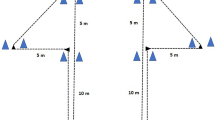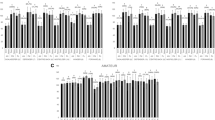Abstract
Introduction
Physical fitness and trunk stability are essential factors for successful soccer competition.
Materials and methods
We investigated the impact of soccer exposure on the trunk muscle profile of players of different skill levels. Professional and amateur soccer players were examined for trunk flexibility and maximum isometric muscle strength in the midseason period 2011.
Results
24 professional soccer players who had not participated in any specific trunk muscle training programmes had significantly higher isometric trunk muscle strength in the sagittal plane (Ext: p = 0.003, Flex: p = 0.014), the frontal plane (Lat. right: p = 0.001, left: p = 0.003) and the transverse plane (Rotation right and left: p < 0.001) than 83 amateur soccer players. Professional players also had higher trunk flexibility in the sagittal plane (Flex: p = 0.001) and the transverse plane (Rotation right: p = 0.02, left: p = 0.002) than amateur players. The side of the dominant kicking leg had no influence on muscle strength and flexibility of the trunk.
Conclusion
Trunk flexibility and stability as necessary factors for avoiding physical overstress and injuries are differently trained in player of different soccer skill levels.

Similar content being viewed by others
References
Nesser TW, Huxel KC, Tincher JL, Okada T (2008) The relationship between core stability and performance in devision I football players. J Strength Cond Res 22:1750–1754
Stolen T, Chamari K, Castagna C, Wisloff U (2005) Physiology of soccer: an update. Sports Med 35:501–536
Kearns CF, Isokawa M, Abe T (2001) Architectural characteristics of dominant leg muscles in junior soccer players. Eur J Appl Physiol 85:240–243
Haaland E, Hoff J (2003) Non-dominant leg training improves the bilateral motor performance of soccer player. Scand J Med Sci Sports 13:179–184
Thorborg K, Couppé C, Petersen J, Magnusson SP, Hölmich P (2011) Eccentric hip adduction and abduction strength in elite soccer players and matched controls: a cross-sectional study. Br J Sports Med 45:10–13
Hewett TE, Di Stasi S, Myer GD (2013) Current concepts in injury prevention in athletes after anterior cruciate ligament reconstruction. Am J Sports Med 41:216–221
Behm DG, Drinkwater EJ, Willardson JM, Cowley PM (2010) The use of instability to train the core musculature. Appl Physiol Nutr Metab 35:91–108
Zazulak BT, Hewett TE, Reeves NP, Goldberg B, Cholewicki J (2007) Deficits in neuromuscular control of the trunk predict knee injury risk: a prospective biomechanical-epidemiologic study. Am J Sports Med 35:1123–1130
Myer GD, Brent JL, Ford KR, Hewett TE (2008) A pilot study to determine the effect of trunk and hip focused neuromuscular training on hip and knee isokinetic strength. Br J Sports Med 42:614–619
Hawkins RD, Fuller C (1999) A prospective epidemiological study of injuries in four English professional football clubs. Br J Sports Med 33:196–203
Dvorak J, Junge A (2000) Football injuries and physical symptoms: a review of the literature. Am J Sports Med 28:S3–S9
Ferreira PH, Ferreira ML, Maher CG, Refshauge K, Herbert RD, Hodges PW (2010) Changes in recruitment of transversus abdominis correlate with disability in people with chronic low back pain. Br J Sports Med 44:1166–1172
Mannion AF, Taimela S, Müntener M, Dvorak J (2001) Active therapy for chronic low back pain part 1. Effects on back muscle activation, fatigability, and strength. Spine (Phila Pa 1976) 26:897–908
Weishaupt P, Obermüller R, Hofmann A (2000) Spine-stabilizing muscles in golf players. Z Sportverl Sportschad 2:55–58
Schmid T, Mederer A, Weishaupt P, Möckel F, Prochnow T (2002) Spine-stabilizing muscles in runners. Z Sportverl Sportschad 16:59–63
Miltner O, Siebert C, Tschaepe R, Maus U, Kieffer O (2009) Muscular trunk stability in professional and amateur volleyball players. Z Orthop Unfall 148:204–209
Wilson JD, Dougherty CP, Ireland ML, Davis IM (2005) Core stability and its relationship to lower extremity function and injury. J Am Acad Orthop Surg 13:316–325
Fuller CW, Ojelade EO, Taylor A (2007) Preparticipation medical evaluation in professional sport in the UK: theory or practice? Br J Sports Med 4:890–896
Rösch D, Hodgson R, Peterson TL, Graf-Baumann T, Junge A, Chomiak J, Dvorak J (2000) Assessment and evaluation of football performance. Am J Sports Med 28:S29–S39
Zachiorskij VM, Aurin AS, Selujanov VN (1984) Biomachanik des menschlichen Bewegungsapparates. Sportverlag, Berlin
Graves J, Pollock M, Carpenter D, Leggett SH, Jones A, MacMillan M, Fulton M (1990) Quantitative assessment of full range-of-motion isometric lumbar extension strength. Spine 15:289–294
Borghuis AJ, Lemmink KA, Hof AL (2010) Core muscle response times and postural reactions in soccer players and non-players. Med Sci Sports Exerc 43:108–114
Lehance C, Binet J, Bury T, Croisier JL (2009) Muscular strength, functional performances and injury risk in professional and junior elite soccer players. Scand J Med Sci Sports 19:243–251
El Rassi G, Takemitsu M, Woratanarat P, Shah SA (2005) Lumbar spondylolysis in pediatric and adolescent soccer players. Am J Sports Med 33:1688–1693
Stofft E, Grosam KH (1975) Sports and the spine. Anat Anz 137:369–380
Ekstrand J, Gillquist J (1982) The frequency of muscle tightness and injuries in soccer players. Am J Sports Med 10:75–78
Mikkelsson LO, Nupponen H, Kaprio J, Kautiainen H, Mikkelsson M, Kujala UM (2006) Adolescent flexibility, endurance strength, and physical activity as predictors of adult tension neck, low back pain, and knee injury: a 25 year follow up study. Br J Sports Med 40:107–113
Jamtvedt G, Herbert RD, Flottorp S, Odgaard-Jensen J, Håvelsrud K, Barratt A, Mathieu E, Burls A, Oxman AD (2010) A pragmatic randomised trial of stretching before and after physical activity to prevent injury and soreness. Br J Sports Med 44:1002–1009
Hoff J (2005) Training and testing physical capacities for elite soccer players. J Sports Sci 23:573–582
Hides JA, Stanton WR, McMahon S, Sims K, Richardson CA (2008) Effect of stabilization training on multifidus muscle cross-sectional area among young elite cricketers with low back pain. J Orthop Sports Phys Ther 38:101–108
Bahr R, Andersen SO, Loken S, Fossan B, Hansen T, Holme I (2004) Low back pain among endurance athletes with and without specific back loading—a cross-sectional survey of cross-country skiers, rowers, orienteers, and no athletic controls. Spine 29:449–454
Walden M, Hagglund M, Ekstrand J (2005) UEFA Champions League study: a prospective study of injuries in professional football during the 2001–2002 season. Br J Sports Med 39:542–546
Hoshikawa Y, Iida T, Muramatsu M, Nakajima Y, Fukunaga T, Kanehisa H (2009) Differences in thigh muscularity and dynamic torque between junior and senior soccer players. J Sports Sci 24:1–10
Stewart S, Stanton W, Wilson S, Hides J (2010) Consistency in size and asymmetry of the psoas major muscle among elite footballers. Br J Sports Med 44:1173–1177
Conflict of interest
The corresponding author confirms that in the manuscript “Sport-specific trunk muscle profiles in soccer players of different skill levels” is no conflict of interest. There is no sponsoring organisation.
Author information
Authors and Affiliations
Corresponding author
Rights and permissions
About this article
Cite this article
Krutsch, W., Weishaupt, P., Zeman, F. et al. Sport-specific trunk muscle profiles in soccer players of different skill levels. Arch Orthop Trauma Surg 135, 659–665 (2015). https://doi.org/10.1007/s00402-015-2178-x
Received:
Published:
Issue Date:
DOI: https://doi.org/10.1007/s00402-015-2178-x




